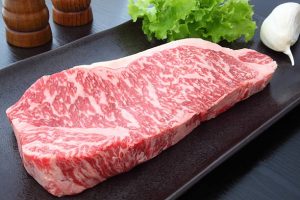
Where’s the beef… from?
Pemberton cattle growers go natural
Don Millerd is an affable guy. He’s got a one-liner he’s likely delivered a hundred times, but it’s still charming: “Ten years ago I couldn’t even spell ‘cow’,” he says with a laugh from his office in North Vancouver.
The punch line should be “and now I is one.” But in his case as co-owner of Pemberton Meadows Natural Beef and self-described neophyte in the beef business, we’d have to change that to “and now I grows them.” At least Millerd helps grow them with his equally affable partner, Bob Mitchell. (Cattle insiders do say “grow”.)
In beautiful Pemberton Valley, Mitchell, along with other farmers in the area, raises and finishes beef cattle for the Pemberton Meadows Natural Beef brand.
And what happy low-stress cattle they are, generating happy local farmers – who’ve been able to make a living when they might not have otherwise – as well as some pretty happy beef eaters.
We love our beef, we humans, so we share our planet with a heck of a lot of cattle. According to Gira, an international market research group, almost a billion beef cattle are being raised for dinner tables worldwide, about 12.3 million of them in Canada, primarily in Alberta and Saskatchewan. That’s about one head of beef for every three Canadians.
Approximately half of Canadian beef is exported, but we still have enough left to chow down plenty. On average, every Canadian eats 20.2 kg (44.5 lb) of beef each year.
Most of us get our beef – in fact, virtually all of our meat – in pristine, plastic-wrapped packages from our local grocery stores. But given the nature of Canada’s commercial beef system, which generates the more than 90 per cent of beef not provided by operations like that in Pemberton, we haven’t a clue how a steak or roast goes from hoof to plate.
From disaster to delightful surprise
At least two good things arose from the BSE (bovine spongiform encephalopathy) disaster that crippled the Canadian cattle industry in mid-2003: Canada developed Verified Beef Production, one of the best cattle tracking systems in the world, and Pemberton Meadows Natural Beef was born.
At the time Bob Mitchell was raising calves on the 200-acre family farm he’d grown up on in Pemberton Valley since the 1950s. His part-time neighbour since the ’60s, Don Millerd, had just bought another nearby property and was wondering what to do with it.
Back then, Mitchell would raise his calves until they were about six months old then sell them at auction for finishing. This is the way most B.C. cattle are typically raised – some kind of cow-calf operation that entails finishing, which means feeding and growing calves at a feedlot to a size suitable for butchering. Backgrounders are also often used – farmers or companies who buy calves to grow them larger before they go to feedlots.
According to John Church, professor at Kamloops’ Thompson Rivers University and an expert in cattle industry sustainability, more than 90 per cent of Canada’s prime cattle (two-year-olds) are finished in feedlots. Cull animals – old bulls, old cows and even old dairy cows – are also part of the supply but since they don’t need fattening they go “straight to ground,” meaning ground beef.
About 75 per cent of all Canadian cattle, including most from B.C., end up in “feedlot alley” in southern Alberta, where a single feedlot can hold up to 25,000 animals. Nearby are the two biggest meat processing plants in Canada: Cargill at High River and XL Foods in Brooks. Together they process about 9,000 animals a day, some 80 per cent of Canadian beef. Good chance they might have handled some of Mitchell’s animals back in 2003.
“We were selling about 40 calves a year, but we were stuck in a seasonal operation,” Mitchell says.
When mad cow disease hit, prices for six-month calves halved to 60 cents a pound as the U.S., Canada’s largest export market, slammed its doors to Canadian beef and cattle. Some cattlemen went bust.
“So Don and I decided we would go straight to the table – grow it, raise it and finish it ourselves, from calf to market,” says Mitchell from his farm, where his crazy blue heeler cross, Percy, has just woken him from a nap.
You can’t miss the Millerd/Mitchell farms. At each driveway entrance are signs bearing the distinctive orange and brown Pemberton Meadows Natural Beef logo.
In fact, it was their branding and marketing that helped the operation move beyond the struggle of its first few years. But it’s the way they raise and process the beef that leaves people hungry for more.
When they’re born, Mitchell’s calves – mostly red Angus and Simmental – weigh 70 to 90 pounds (32 to 41 kilograms). Every year he keeps a few of the best calves for breeding. The rest will go to beef when they’re two years old and weigh 1,200 to 1,400 pounds (550 to 635kg).
The newborns drink their mother’s milk; at about a week old, they start nibbling hay. Within a month they can eat enough hay that their four-stomach system, called a rumen, starts regurgitating cud to chew.
Up to age six months it’s all hay and milk, then Mitchell introduces a bit of grain supplement, usually oats. For the next six months, it’s oats and hay then the animals go out on pasture for another six months and graze on their own.
“That’s the cheapest pounds I can put on them,” he says. “I don’t have to make hay out of it and they gain one to one-and-a-half pounds each day.”
At the end of the second summer until their final spring, it’s winter feed: hay, barley and barley mash left from beer making at nearby Whistler Brewery. In fact, virtually all feed the animals get is local – Mitchell buys some barley when his runs out.
During their lives, the animals also get selenium, which the soil lacks, and one shot of vitamins A, D and E. The “natural” in Pemberton Meadows Natural Beef means no hormones, no steroids, no antibiotics and using natural feed with no animal by-products.
By contrast, cattle finished in feedlots receive some form of non-therapeutic antibiotics, says Church. “It’s certainly used prophylactically before the animals get sick, and they also discovered the animals would grow faster. Often they get it daily in the feed.” Most of the animals also receive artificial hormones via an ear implant, which make them grow faster as well.
When the Pemberton Meadows cattle have fattened up nicely, at about two years of age, they’re ready for the next step in their destiny: an abattoir that Mitchell likes because it’s clean and fast.
Meadow Valley Meats’ Pitt Meadows plant also happens to be halal, so the meat processed there meets Islamic requirements.
“Scientific research has proven halal techniques cause much lower stress and suffering to the animals than conventional processing, so it’s much more humane to do it that way,” says plant manager Azhar Kazi.
The animals come in one day before processing and are off-loaded into a comfortable pen where they can drink water and rest because it’s better for the beef.
“If they are too stressed, it can cause the meat to discolour and be tough because of the hormones that act on it,” Kazi says.
On processing day, the steer or heifer is led into a confining “knock box”, where a steel door separates it from other animals. A captive bolt pistol is used to deliver a blow to the head and render the animal unconscious.
Once it falls to the floor its throat is quickly slashed with an extremely sharp knife, killing the animal almost instantly. Then the carcass is raised by the hind legs to drain the blood. (In conventional processing the animal is also rendered unconscious with a captive bolt pistol, then the head is severed and a knife is used to stab the heart.)
The carcass is then skinned, the guts and head removed, then it’s split into two sides. At this point, inspectors from Canadian Food Inspection Agency (CFIA) to ensure the animal is disease-free examine the heart, kidneys, liver, thyroid and pituitary gland.
Once the sides pass first inspection, any cross-contamination, such as dirt from the hide, and excess fat are removed, and they’re treated with citrus acid and washed. After a final CFIA inspection, the tag number and weight are noted and the sides are hung in a drip cooler.
The whole process takes only about half an hour.
Next day, the sides go into a holding cooler, where they’re kept for at least 24 hours or until the interior temperature reaches four degrees or lower. Then they’re graded based on the age, size, confirmation, marbling and fat colour before being quartered and trucked to Two Rivers Specialty Meats, a full processing and meat distribution facility in North Vancouver.
The final weight: about 700 to 750 pounds of meat (315 to 340kg), or about half of what the animal weighed on the hoof.
* * *
When it comes to flavour and texture, the way beef – or any meat – is processed is as important as the way the animals are raised and slaughtered.
For Pemberton Meadows Natural Beef, aging is a huge component. When you age meat, enzymes break down the muscle fibres so the meat isn’t as tough.
“You could have meat that’s raised incredibly, and then it gets processed and gets knocked onto a rack for a couple of days, and it goes right down a few notches,” says Jason Pleym.
He and his wife, Margot, opened Two Rivers Specialty Meats a few years ago with one customer: Pemberton Meadows Natural Beef. Today specialty meats constitute 80 per cent of their products, with farmers from Chilliwack to Pemberton supplying chickens, ducks, game birds, lamb, buffalo, venison and more.
“We have a few different tiers of products because not everybody wants to have specialty meat,” he says. “But what we focus on is bringing a farmer’s product to the market and telling their story.”
Before starting Two Rivers, Pleym worked years in the meat supply business. He was raised in the Kootenays where his family hunted deer, moose and elk, so he knows his meat and works closely with his customers to deliver what they want.
When the quarters of Pemberton Meadows Natural Beef are delivered from the abattoir, they’re hung for another four or five days, so total hanging time is about 10 days.
The beef quarters are then broken down. Typically, prime cuts like strip loins and rib eyes are cut into rough cuts on the bone, then dry aged on racks in a big cooler for anywhere from 28 to 40 days, depending on what customers want. The rough cuts are not covered, they’re arranged in neat rows to allow cold air to circulate all around them.
“Dry aging affects flavour, for sure,” Pleym says. “It’s like reducing a sauce – you’re taking the moisture content out of the meat, which is doing two things. It’s intensifying the flavour and it’s also breaking it down a bit differently than you find in a wet aging process in a Cryovac bag, which is typically how less prime cuts go through.”
The wet aging process at Two Rivers is similar to that used in most commercial meat processing. Essentially, the meat is placed in a Cryovac or vacuum-sealed bag in a big cooler and liquids purge out. The time durations will vary, depending on the brand and requirements, but most commercial beef isn’t wet aged very long, producing a product with more water content.
“Ninety-five per cent of the beef industry would age product this way because there’s minimal (weight) loss,” Pleym says.
Once the Pemberton Meadows Natural Beef has aged, it’s cut, trimmed and packaged then delivered to restaurants and retailers.
James Walt, award-winning executive chef who strives for local, sustainable ingredients, gave the beef its restaurant debut at the distinguished Araxi in Whistler.
“The big thing was Pemberton Valley was supplying so much produce and stuff to us already but the one thing we didn’t have was meat of any kind. So when we found out about it we hopped on board just because of geography,” says Walt.
Since then, the beef’s flavour and performance have continued to earn it a place on Araxi’s menu and at other fine restaurants, butcher shops and grocery stores throughout Whistler, the Lower Mainland, the Okanagan and Vancouver Island.
* * *
To Millerd, the way everything has evolved is a delightful surprise. People are having fun and the business is growing.
Pemberton Meadows Natural Beef now runs cattle on close to 400 acres and gets roughly 25 per cent more than standard prices for their cattle. Half a dozen other farmers in the valley – the Kuurnes and their son; the Ronaynes; the McEwens; Dave Hellevang and Doug Gilmore – now raise calves for the operation, too.
“I think, yahoo!” Millerd says. “A lot of people are earning a living at it!”
That includes Two Rivers Specialty Meats, which now employs about 25 people.
At a time when half a generation in Canada has abandoned cattle ranching, he’s really excited that Roxy and Mark Kuurne’s son, Peter, has been able to start his own viable operation by selling cows to Pemberton Meadows Natural Beef.
To spread the delight, Millerd recently purchased a 340-acre ranch near Cache Creek, where he plans to start Cache Creek Natural Beef with 250 head, a pretty average-sized herd for B.C. A big focus will be helping young people in the beef business.
There’s one more thing: besides the happy cows, the good meat and the jobs, Mitchell and Millerd are growing something else.
“What’s very interesting about an operation like they have is how much they’re raising awareness about agricultural production in their community,” says Elaine Stovin at the BC Cattlemen’s Association. “For sure any local producer who sells locally helps people know where their food comes from.”
It’s all in the beef
An empathy for all things beef runs naturally through my blood.
I grew up in Alberta. My granddad was a cowboy in the Okanagan about 100 years ago. One of my favourite photos shows him riding horseback, standing tall on top of the saddle, not in the stirrups, and grinning like a fool. My great grandfather ranched in the foothills west of Calgary, an area now called Cowboy Trail.
To me, unwrapping a piece of Pemberton Meadows Natural Beef is like unwrapping a gift. Today it’s a gorgeous strip loin, red mahogany in colour with a strip of creamy white fat along one side and some fatty marbling. It weighs about 10 ounces, considered by some to be a perfectly sized serving for steak. But my husband and I find this meat so dense and satisfying we easily share it.
I cook it simply, searing it in a hot pan. The outside browns beautifully and fast, turning a rich walnut brown. Solids caramelize and some of the fat melts, but there’s no outpouring of watery liquid that often occurs when I try to brown typical commercial beef.
When we cut into it, the big flavour and firm texture reminds me of beef I haven’t enjoyed since I was a kid. Is it possible?
“Absolutely,” says Church, explaining that it has much to do with the way the most cattle are finished now.
“There has always been some grain finishing on farms but the big feedlots really got rolling post-World War II. It was an offshoot of the Green Revolution – Norman Bourlog and those guys had some plant-breeding tricks, but the main change was that we substituted energy for labour so we got the tractors and the fertilizers going in through the 1950s.”
Bourlog was known as the father of the Green Revolution, a series of initiatives and new technologies from the 1940s, which increased agriculture production around the world.
By the ’60s and ’70s, grain supply dramatically increased, the price dropped and somebody got the idea to feed all this grain to cattle.
“The one thing feedlots did was make the beef more consistent. I don’t think they’ve made it better,” says Church. “Some of the best steaks I’ve had were grass-finished and some of the worst steaks I’ve had were grass-finished.”
Good thing we have lots of choice in our beef supply. We tend to like what we’re used to, and some people simply don’t like Pemberton Meadows beef. (Walt suggests trying it twice.)
Then there’s the price factor. It does cost more than conventional beef, which is usually grade AA; it’s about the same price as most AAA beef, but less than organic or free-range.
Even so, to me it’s worth it. I’m not a food industry professional but I’m with chef Andrea Carlson at Bishops restaurant in Vancouver. She says Pemberton Meadows Natural Beef is the best they’ve ever used.



